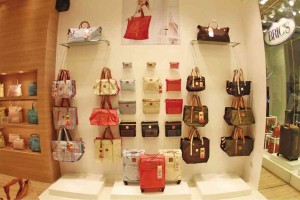
Filipino movie fans with an eye for fashion know what Bric’s is all about, even before the Italian bag company based in Como opened its first two exclusive boutiques in the Philippines recently.
And its name has nothing to do with red-hot emerging economies such as Brazil, Russia, India and China, but more with such Hollywood blockbusters as the “The Twilight Saga: Breaking Dawn,” “Mamma Mia!,” “The Tourist’’ and “Sex and the City 2.”
Bric’s is short for Briccola, the family behind the “medium high-class” line of travel bags—from suitcases to overhead trolleys as well as men’s and women’s shoulder bags, weekenders and totes.
Attilio Briccola, the brand’s commercial director and the seventh among eight children of founder Mario Briccola, recently visited Manila to grace the opening of Bric’s Shangri-La Plaza Mall and SM Aura stores.
Family business
The brand, which marked its 60th year in 2012, has remained a family business all these years. Rustan’s first introduced Bric’s to the Philippine market some years back before 128
Dream Fountain Corp., also the local distributor of Cole Hahn, became its exclusive retailer in the Philippines. It also provides after-sales support.
Bric’s factory in Como, in the Lombardy region of Northern Italy, employs a lean-and-mean staff of 120 people. The company also outsources production to Romania, Moldavia and China. Most of its products, especially those made of soft materials like leather, are assembled in Italy, while the hard-case line is done in China.
“Through the years, we’ve added fashion bags for travel,” said Briccola, “but our core business has always been premium travel bags. In Europe and the United States, we sell more travel bags. But in Asia, including Korea, our fourth largest market, it’s 50-50 between travel bags and handbags.”
Although Briccola is proud of the fact that Bric’s can hold its own with such luxury brands as Louis Vuitton, Prada and Gucci (Bric’s Galleria Milano store competes head-to-head with these leading global labels), he considers Tumi, Rimowa and Samsonite’s high-end line as the brand’s direct competitors.
“We’re not as expensive as Louis Vuitton or Gucci,” he clarified. “Our prices are a fraction of theirs, but Bric’s quality and brand awareness are high.”
No product placements
And contrary to conventional wisdom, Bric’s didn’t pay the producers of Hollywood movies to feature its products. In short, there were no product placements involved.
The decision, for instance, for Edward Cullen (Robert Pattinson) to carry a Bric’s trolley and weekender on honeymoon night with Bella Swan (Kristen Stewart) rested on “Twilight’s” production designers.
“We didn’t pay them to use our products,” Briccola insisted. “They bought the products because I guess they were looking for something special to show in their movies. It’s a testimonial that we offer something special. Otherwise, they would have just bought some other brand.”
And if the likes of Louis Vuitton and Prada are known for using laminated canvas and nylon fabric, respectively, Bric’s also has its trademark material in the form of embossed and leather-like PVC mixed with cotton. Not only is the material attractive and versatile, it can withstand the constant wear and tear associated with long-haul travel.
The material is also low-maintenance, said Briccola, as it can be safely cleaned with water and mild soap. Apart from classic models, Bric’s makes it a point to introduce seasonal styles for spring-summer and fall-winter. Its trademark PVC material comes in such colors as chocolate brown, olive, camel, deep red and, for spring-summer, light blue.
“We call the collection made of PVC ‘Life,’” said Briccola. “It’s our face to the world. People recognize Bric’s because of this material. Some companies in China have attempted to produce the material, but the look and quality aren’t the same.”
Subtle changes
Except for subtle changes in design to reflect shifts in form and function as well as advances in technology, a good number of Bric’s bag lines have remained basically unchanged through the years. The Life collection, for instance, has been around for 17 years now.
“At the same time, we constantly introduce new styles that the market can look forward to,” said Briccola. “We have bags, for instance, that follow the colors of the season.”
While Bric’s travel essentials are decidedly unisex, its handbag line made mostly of nylon in various colors and prints, and accented with leather components (think of it as a smarter, more streamlined version of the ubiquitous Longchamp nylon-and-leather bag) is heavily tilted toward women.
Actually, close to 70 percent of styles that make up Bric’s line of casual bags is geared toward women, said Briccola. To close the gap, Bric’s hired Pininfarina, a design team named after the late Italian designer behind some of Ferrari and Alfa Romeo’s iconic styles, to design a line of casual and hard-case travel bags for men.
“We started designing together a line of luggage eight years ago,” said Briccola. “The co-branding effort has both of the companies’ names on bags, which appeal more to men.”
As far as Bric’s goes, Briccola is confident of the Philippine market’s potentials. Since there’s already a “premium high-class” presence of brands catering to the ultra rich, Briccola hopes to position his brand to appeal to the less crowded “medium high-class” segment in search of stylish and durable travel bags at more affordable prices.
PHOTOS BY RICHARD REYES